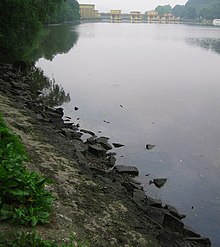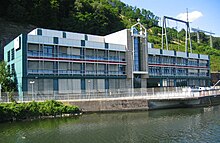Herdecke pumped storage power plant
| Herdecke pumped storage power plant | |||
|---|---|---|---|
| View from the south over the Hengsteysee to PSP Herdecke (left) and Koepchenwerk (right) | |||
| location | |||
|
|
|||
| Coordinates | 51 ° 24 '41 " N , 7 ° 27' 14" E | ||
| country |
|
||
| place | Herdecke | ||
| Waters | Hengsteysee ( Ruhr ) | ||
| Data | |||
| Type | pumped storage power plant | ||
| power | 153 MW | ||
| owner | RWE | ||
| operator | RWE Power AG | ||
| Project start | 1927 | ||
| Start of operations | January 28, 1930 (old work) August 8, 1989 (new work) |
||
| Shutdown | 1994 (old work) | ||
| turbine | 1 × Francis pump turbine | ||
| Website | RWE | ||
| was standing | 2020 | ||
The Herdecke PSP is the successor to the Koepchenwerk pumped storage power plant and is owned by RWE . It is located on the Hengsteysee in the city of Herdecke in North Rhine-Westphalia .
history
construction
In December 1980, the housing of one of the pumps at the Koepchenwerk tore , and investigations showed the immediate risk of similar damage to two other pumps. RWE therefore decided in 1981 to build a new pumped storage power plant, the Herdecke PSW, at the same location, and to shut down the old plant.
Between 1985 and 1989, the modern power plant was built right next to the old plant on the lake shore. This continues to use the same principle. The most noticeable difference, apart from the new power plant building, is that the pressure pipes now run underground and are no longer visible.
In 2007 the owner RWE invested 25 million euros in modernizing the power plant in Herdecke. The work lasted from May to September 2007.
technology

The power plant built in the 1980s is used to cover peak loads . During periods of low electricity demand (mostly at night), water is pumped from the reservoir into the storage basin, which is a good 160 m higher on a mountain. During periods of increased electricity demand (mostly during the day), the water then flows back into the lake through pipelines and a large reversible Francis pump turbine . As a result, up to 153 MW of electrical power can be produced for up to four hours today. The turbine can be run from standstill to full load within 70 seconds. The turbine itself is located 42 m below the water level of the lake in a shaft.

The large difference in height results from the need to exclude any risk of cavitation when pumping . The shaft of the turbine and generator is arranged vertically, the rotor of the generator weighs over 300 tons . The connection to the upper water by a rock in the blown-up 396 m long tunnel provided by a single pipe of nominal diameter leads DN 4750th At the inlet to the pump turbine there is a ball valve with a nominal width of DN 3300, which at the time of its manufacture was the largest of its kind in the world. The valve can be closed with hydraulic cylinders within 32 seconds.
The start-up of the entire system in pumping mode is made possible by a frequency converter with 20 MW output. As of 2017, this frequency converter is the largest in Europe.
The storage basin, which is adapted to the hilltop, has a length of approx. 600 meters and a width of approx. 250 meters and a capacity of over 1.5 million m³. The concrete surfaces in and around the reservoir were renovated in 2007.
| Technical data of the new power plant | |
|---|---|
| Content of the upper basin: | 1,600,000 m³ |
| Usable content: | 1,533,000 m³ |
| Drop height: | 165.2 m to 145.5 m |
| Construction time: | 1985-1989 |
| Installation: | August 8, 1989 |
| Expansion flow in pumping mode: | 101.7 m³ / s |
| Expansion flow in turbine operation: | 110 m³ / s |
| Power in pumping mode: | 153.59 MW |
| Power in turbine operation: | 153 MW |
| Work content of the upper basin: | 649,000 kWh |
| Electrically usable work content: | 590,000 kWh |
| Max. Pump storage efficiency : | 80 % |
| Speed of generator, pump and turbine: | 250 revolutions per minute |
Network connection
The power plant is connected to the Garenfeld switchgear via a 4.8 km long overhead line . The mains connection is on the 220 kV high voltage level in the transmission grid of Amprion . The overhead line with 17 electricity pylons spans the Hengsteysee and runs along the southern shore of the lake to the transformer station.
As part of the planned new construction of the high-voltage line Kruckel – Dauersberg , the connection line to the pumped storage power plant will also be renewed by 2021. The connection is to be carried out over about six kilometers on the masts of the new high-voltage line to the Kruckel substation . The 220 kV overhead line built in 1927 can then be dispensed with and dismantled.
Battery storage
At the beginning of 2018, RWE Generation put a stationary battery storage power plant into operation on the site of the pumped storage power plant. The storage system consists of 552 battery modules from the manufacturer Belectric , each with 100 lithium-ion cells from the automotive sector. The storage has an output of 7,800 kilovolt amperes with seven megawatt hours of storage capacity, which can be fed into the grid for around an hour.
ecology

Due to the daily pump storage operation, the water level of the Hengsteysee , which serves as the lower basin, can fluctuate by 70 cm within a short time (between +95.6 m above sea level and +96.3 m above sea level). This has significant consequences for marine ecology. The bank vegetation is correspondingly reduced and many birds that usually breed on the bank can only do this with great difficulty or only with artificial aids. In addition, smaller living beings (including fish) are caught in the suction of the pumps despite the screening devices and do not survive the power plant processes, especially the high pressures in the pipes.
Herdecke operations group
About one kilometer downstream, at the end of the Hengsteysee, there is another power plant, the Hengstey run-of-river power plant .
RWE radio tower
The facility also includes a 79 m high radio tower constructed as a reinforced concrete structure near the upper basin.
See also
literature
- Hans Dieter Dörre: Storage basins on the Kleff and Hengstey lakes - a concept is recognized in Europe - a structure erected in Herdecke at the end of the 1920s. - Article in: Herdecker Blätter. Issue 3 (May 1993), pages 9-14
- Ralf Blank: The city of Hagen in the bombing war . In: Gerhard E. Sollbach (ed.): Hagen 1939-1948. War and post-war period . Hagener Stadtgeschichte (n), Vol. 4. Hagen 1994. pp. 9-26.
- RWE Power AG: Herdecke pumped storage power plant , Essen
Web links
- 75 years of the Herdecke power plant - historical core, modern technology (June 2005). (PDF file; 329 kB)
- Metropolis Ruhr: The Koepchenwerk as a sight
- Description of all locations on this themed route as part of the Route of Industrial Culture
- 360 ° panorama power plant Koepchenwerk (Sept. 2011) WDR
Individual evidence
- ↑ List of power plants. Federal Network Agency , November 11, 2019, accessed on December 11, 2019 .
- ^ EnLAG, project 19: Kruckel - Dauersberg. Federal Network Agency , accessed on March 24, 2020 .
- ↑ Explanatory report for the 380 kV Kruckel – Dauersberg line. (PDF) Section Kruckel – Garenfeld. Amprion , accessed March 24, 2020 .
- ↑ Herdecke battery storage. RWE , accessed on March 24, 2020 .




